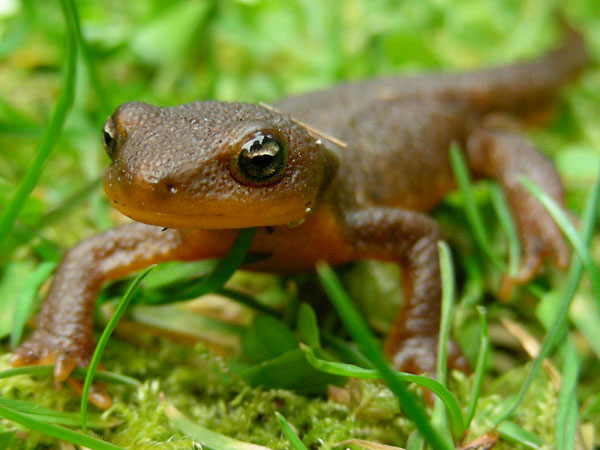Form and Function
Size
Adult Rough-skinned Newts are usually between 6.4 cm and 8.9
cm from snout to vent or anus which is located just before the tail,
and roughly 8.9cm to 20cm in total length (California
Herps 2013).
Appearance
The Rough-skinned Newt is known to come in a few variations
of color being; black, brown, reddish-brown, or a light brown on the
top side of the newt, with a yellow or orange underbelly. An example
of these colors for a Rough-skinned Newt can be seen in the baby
newt picture on the right side of the screen. The newt has a dry and
granular skin with no Costal groves or ridges between the ribs (California
Herps 2013). The newt has dark eyelids and yellow irises.
Populations have been known to have dark splotches on their backs.
When males are breeding they develop a smoother lighter skin, a
flattened tail used to aid in swimming, and rough pads on the
undersides of the feet to aid in grasping females due to the fact
mating is done underwater (California Herps
2013).

Adaptations to environment
The Rough-skinned Newt becomes aquatic when preparing to
breed or undergoing breeding. Some populations have been known to
become nocturnal, and others primarily aquatic as opposed to
terrestrial which is the norm for the Rough-skinned Newt. During
fall in most terrestrial populations, rain-fall will trigger the
newt to begin wandering forage (California
Herps 2013).
The Rough-skinned Newt as evolved a defense mechanism
utilizing both poison and bright colors.
When in danger the newt curls its head and tail back towards each
other. Doing so reveals its bright orange underbelly warning
predators that the newt is poisonous and should not be eaten. During
this time the newt also begins excreting toxins onto the surface of
its own skin (California Herps 2013).
The poison within the newt is known as a tetrodotoxin, this is a
neurotoxin that will cause death in most animals, and this includes
humans. The toxin can be dangerous through consumption, ingestion
through a mucous membrane, or even through a![]() cut. This toxin is so potent, it could kill as many as 25,000 mice
from just one newt. However the toxin is not enough to completely
protect the newt from predation, the garter snake is very resistant
to this toxin and preys upon the Rough-skinned Newt (California
Herps 2013).
cut. This toxin is so potent, it could kill as many as 25,000 mice
from just one newt. However the toxin is not enough to completely
protect the newt from predation, the garter snake is very resistant
to this toxin and preys upon the Rough-skinned Newt (California
Herps 2013).
Movement
The newt is amphibious; therefore it has the ability to
move both on land and within water. The Rough-skinned Newt has two
sets of legs, with four digits on front legs, and five digits on
hind legs.
Reproductive adaptations
Males develop a smoother lighter colored skin,
swollen cloacal lips, and special padding on feet used to grip
females during a mating session. (California
Herps 2013). Females do in fact develop a smoother skin also but
not nearly as dramatic of a change as the male undergoes.
Reproduction is aquatic, the adult
Rough-skinned Newt breeds along the edges of slow streams, lakes, or
ponds in vegetated areas. After mating has completed and the eggs
are fertilized, the female attaches the eggs to shallow submerged
sticks, branches, and leaves. The eggs are in fact also protected by
the same chemical toxin that protects the newts from predators (California
Herps 2013).
In the event that a male Rough-skinned Newt
undergoes a high amount of stress, courtship incidences decrease
within the individual. A study preformed comparing the correlation
of plasma corticosterone concentrations and mating incidences. The
study found that under high stress the male newt will release
corticosterone into its bloodstream, and the higher the
concentration of this hormone the less likely a mating incidence
will occur with that male (Moore and Miller
1984).